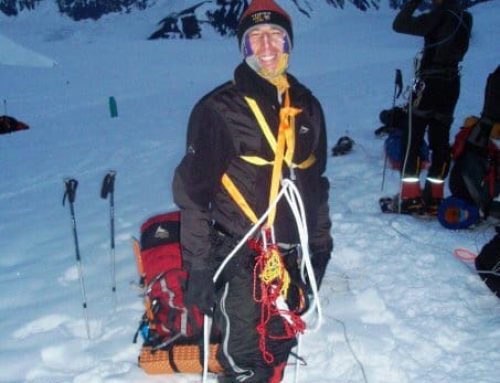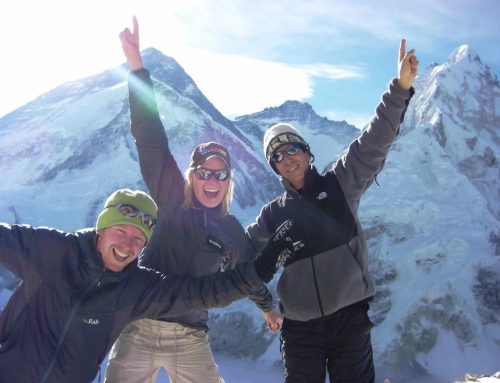
One satellite phone, one iPhone, several iPods, two digital cameras, one HD video camera, and a Kindle all traveled to Mount Everest with me leveraging 3G, Internet and Wi-Fi networks, social media and photo sharing sites, several email accounts, voice-mail, and this web-site. These are all technology advancements that date back to the 1948 invention of the transistor (by Bell Labs) and the publication in the same year of “A Mathematical Theory of Communications” by Claude Shannon also of Bell Labs.
I’m in the middle of reading James Gleick’s history of information, titled: “The Information, A History, A Theory, A Flood”, and having spent several decades in the communications industry, I was suddenly struck by the nexus of all of this.
My very first job was distributing information. At age 15 I was a paper boy in Canoga Park California delivering the Herald Examiner newspaper to over 100 households in my neighborhood on my bike. It was strictly analogue. Each afternoon, I had to put a rubber band around each paper, put it in my paper sacks, and take the address list with me to know who had a valid subscription. At the end of each month, I had to go to every household and try to collect a check to pay for the papers that had to be paid to the newspaper company whether I collected the money or not. Some deadbeats never paid. But at least I got a free paper and could follow the Dodgers and Lakers.
My second job was using the telephone. At age 16, I was a telephone sales-person. One of those people that call you up in the evening and try to sell you carpet cleaning. No automated machines, just telephone books and reverse directories (by street address) and cold calling people to tee-up free estimates and get your carpet and upholstery cleaned. It was commission based and I was pretty good. By the time I was 17 and still in high school, I was earning over $200 a week – which was very good money at the time. I soon became a manager of a branch office in Torrance and commuting from the west San Fernando Valley each afternoon, I ran a small operation of trucks, estimators, cleaners and salespeople targeting the affluent sections of the South Bay.
Fast forward all these years and I realize that I have had the opportunity to work for four of the greatest technology, information, and communications companies of all time: AT&T, Ericsson, Microsoft and Juniper. All leaders who have had to reinvent themselves over 130 years for the first two, and over the past 20-30 years for the other two. And to make things interesting, throw in a couple of late-stage start-ups who were leaders in fiber-optic and video communication deliveries.
So, how in the world did all these devices end up going to Everest, using global networks and interacting with anyone on their phones, tablets and PCs?
After doing my entry level job as a 411 operator (“what city please?”), I got a chance to become a real technician! I was transferred to work in a telephone exchange office in North Hollywood where copper cables came in from homes and across the city, country and world, and connected via mechanical switches (step-by-step) and electro-mechanical switches (cross-bar – Ericsson was an early leader, along with Western Electric and Strowger). These vast central offices, which still stand today, were built to withstand earthquakes, nuclear bombs and acts of sabotage (this was pre-terrorism.) If you notice that your phone service goes mostly undisturbed, this is one of the key reasons. These switches took up huge amounts of space in these offices and were dominated by main-frames (not what you think). And … these switches were NOISY. We wore headphones at times, other times at night we cranked up the radio that blasted the mostly empty of human aisles. These steps dated back to a guy named Almon Stowger (who was an undertaker before he developed the first automated telephone exchange in 1881). And they were still in use 80 to 90 years later. I remember the last one being removed from Catalina Island sometime before I left the phone company.
Main frames where just that, several hundred yards of wire frames where we ran jumpers (wires) that connected a phone number to a cable pair and you used a butt-end (a portable telephone handset) to test for dial-tone and to verify that it was the right number connected to the right address.
(There’s a great story on the “rule of seven” in the book. Why phone numbers in the US are seven digits, why seven words and concepts are more or less what people can remember at any one time.)
What I did not realize, and after reading the book, was how much science, physics and information technology had gone into the set-up literally dating back hundreds of years including Samuel Morse (Morse code), Alan Turing (the “father” of algorithms and computer science), Charles Babbage, Brownian and Newtonian physics, and African Drums. Who knew? I was sweeping the floor of wires when not busy connecting things. My first boss, “Big” John used to say “Time to lean, time to routine, baby!”
Our exchange was one of the first in LA to cut-over to the new 5ESS switch – the first electronic switching system (“ESS”). It was manufactured by Western Electric (later to be Lucent and then Alcatel Lucent). At the time 5,000 employees worked on the development effort producing 100 million lines of code. The development supposedly took 20 years and releases came out every three years! … According to the current information repository – Wiki. These things were quiet and required much fewer employees to do the computer work rather than the step-by-step switches.
Later, we would install some of the first fiber optic networks in the world. Before, if you cut the wrong wire, you could bring down a line. One line. Now, if you messed up you could take down 24 strands of light, and thousands of customers, all in the blink of an eye. We went from 8 kilobyte phone lines to 56 kilobyte clear-channel connections for rudimentary data to T1s (1.5 megabyte) and then – all the way to the 405 megabyte systems by Fujitsu. Rotary phones started to be dominated by touch-tone. Some cars had cellular phones – but they were analogue and you had to call an operator to connect you.
And now?
5.5 billion Mobile phones. Billions of cat videos posted on YouTube. E-coupons, Wearables, Autonomous Cars, Private Rockets … In five years, 50 billion units will be connected to the mobile internet – phones, cameras, PCs, tablets, GPS devices, picture frames, dog collars, TVs, gaming stations, and book readers.
And Everest? I could sit in the tent at 17,500′ at Base Camp, turn on my iPhone and read email, get status updates on Facebook, upload pictures from the day and call into staff meetings without leaving the -17 night-time temperatures and curled up in my sleeping bag.
WOW!
While climbing, communications was everything. We transmitted with our mouth and received with our ears. We signaled with our hands, we viewed with our eyes. We did indeed have digital technology. It was binary. When Lakpa Sherpa asked me if it was OK to keep going to the summit at the Hilary Step, I gave a thumbs up. Simple.
Technology would wait until the return. Communicating is everything. We are all a product of our collective history.
I can’t wait to see what the next communications revolution will bring!








